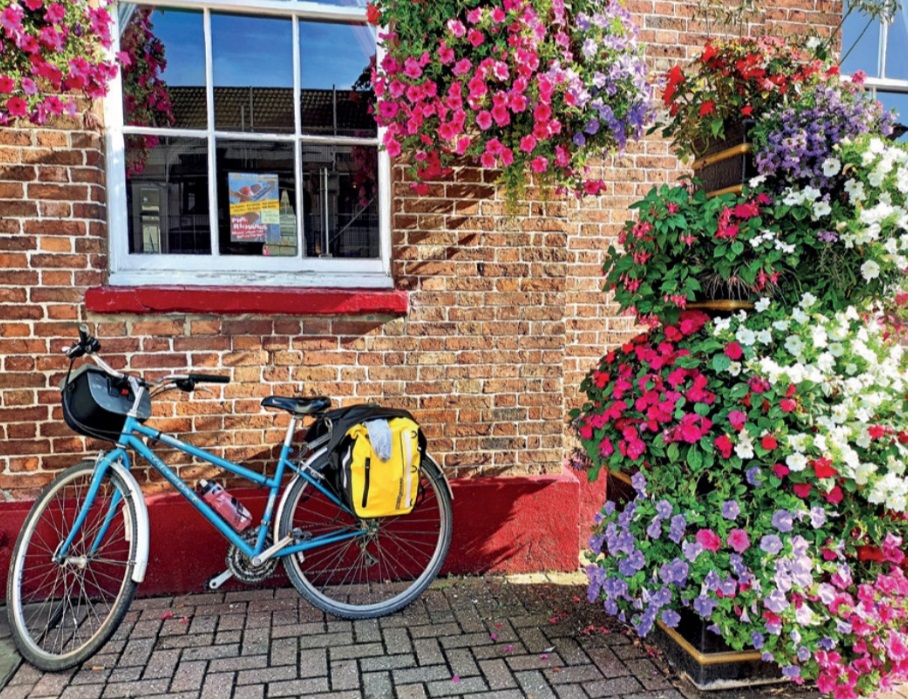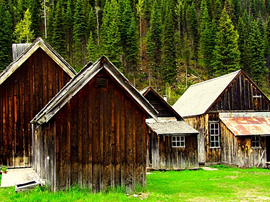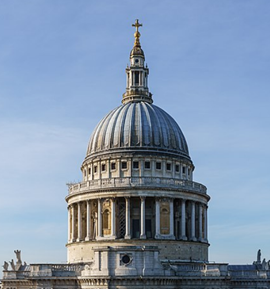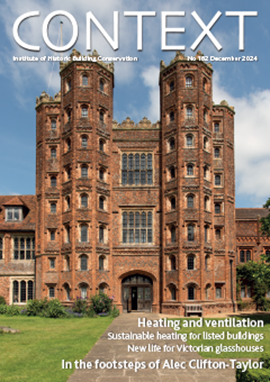Cycling exploration
A tour on Britain’s national cycle network will take you off-road on disused railways and on little-used minor roads, to remote and unexpected places, and little-seen landscapes.

|
| The Londesborough Arms in Market Weighton (Photo: Alison Seymour). |
‘In a car you’re always in a compartment… you’re a passive observer and it is all moving by you boringly in a frame. On a cycle the frame is gone. You’re in the scene not just watching it anymore and the sense of presence is overwhelming. That concrete whizzing past five inches below your feet is the real thing, the same stuff you walk on. It’s right there, so blurred you can’t focus on it…’
In his introduction to Zen and the Art of Motorcycle Maintenance, Robert M Pirsig is talking about a motorcycle journey. But the same logic surely applies to pedallers, and perhaps that is what has motivated me to take an annual holiday on a bit of the national cycle network, with friends Gary, Alison, Louise and John. The network is something we can thank the Millennium Project for. Coordinated by Sustrans, the cycle path charity, there are now 14,700 miles of cycle routes, many off-road on disused railways, or on little-used minor roads that go from nowhere to nowhere. Like Pirsig, we love these back roads. As he puts it, the pace of life is different here, they are not going anywhere. If you take an end-to-end journey (returning by rail), it will be a transect through Britain. It will take you to remote and unexpected places, and little-seen landscapes.
This year we chose Humberside and Lincolnshire, which we thought flat and suitable for our advancing years. Our starting point was York Cathedral and finishing line Lincoln Cathedral. Everyone knows the glories of York Minster. Only cyclists get to see the northern edge of central York. It is a little masterpiece of sensitive regeneration and development. Buildings of just the right height and just the right textures and tones, weaving in perfectly with the waterways.
A few miles further on we are in Stamford Bridge. The visitor centre is shut but Alison is very persuasive and we manage to talk our way in to see a little-known marvel: the Stamford Bridge Tapestry. You may remember that before his ill-fated encounter with the Normans, King Harold had taken the road north to see off Harald Hardrada and his invading Norwegians. Just as the Normans created the Bayeux tapestry to celebrate their victory, the good people of Stamford Bridge have created an amazing, hand-crafted alternative to celebrate King Harold’s victory. It is worth seeing. But we cannot stop for long as we are headed for our first overnight stay in Market Weighton, via Pocklington, a Georgian town marred by an overwhelming, volume-builders housing estate with offensively inappropriate plastic windows.
We are booked into the Londesborough, a comfortable old Georgian coaching inn. It overlooks the churchyard and high on the wall is an old Cyclists Touring Club insignia, spokes and all. Inside there is a remarkable huge, carved semicircular bar with elegant mahogany fittings and glasswork beyond. Oddly, it is not used. I am reminded that the poet Philip Larkin was once librarian at Hull University and another church visitor (Hull is our next stop). It is not difficult to imagine him visiting the church, in awkward reverence with his bicycle clips. A friendly breakfast at the local cafe prepares us for the next leg. It is a steep upgrade out of town, but beyond that a long smooth dip slope that feels like you are on an electric bike. The landscape does not have national identification, but it has a quiet and rolling beauty all the same. As Bill Bryson once said, we do not really need to identify national parks in England because once you have left the city most of the countryside looks like a park.
Next stop is Beverley, identified by the Sunday Times as one of the nicest towns in Britian. It has been wealthy since the wool trade, is architecturally rich and smells of money: smart shoppers, nice cafes, Porsches and SUVs abound. The town has arguably the finest parish church in England. Founded around 700 CE, it was part of the Kingdom of Northumbria, in the north’s greatest (preindustrial) age. Antiquity doubtless informs its civility and wonderfully organic urban morphology. Gently curving streets lead seamlessly from one perfect public space to another. We spot three nuns eating fish and chips at an outside table. A society wedding is taking place at the minster. We could be in Cambridge or Cheltenham or Cahors.
I did not have high expectations of Hull. I was not disappointed. The outer council estates are pretty unlovely, and such an enormous contrast with Beverley. It is like being in a different country. Perhaps we should not be too unfair to Hull, which suffered grievously from bombing in the war and lost a huge amount of its housing.
It is better when we get to the city centre, with its wide streets and dignified 19th-century buildings. Regenerators have been hard at work in Hull. Buildings have been restored and warehouse frontages retained. It is worth the journey but sadly it does not quite cohere yet, with a new road severing the inland from the outlying docks and crossed by an absurd footbridge that could have come from the set of Doctor Who. A wide at-grade pedestrian crossing and a road that looks fit for pedestrians would have been a neater solution. But we do not object to Doctor Who sets in principle. Our Ibis hotel is cheap and very cheerful, with its clever bathroom pods. By finding the right button, one could probably be beamed up to the Starship Enterprise.
Next day is a long haul. We have 40 miles to cover, out of Hull’s suburbs, over the Humber and on to Market Rasen. The Humber Bridge is so much better appreciated from a bicycle on the pedestrian way (with alarmingly low railings). Built by a Labour government keen on buying votes, it has long been decried as a white elephant, but it seems busy enough today. Perhaps there is hope for HS2.
Lincolnshire is famous for its seclusion. If you wish to see it, you must make a special effort to do so. Lying well outside the ellipse of northern industrial England, it is skirted by the mainline railway and motorway to the north. Our route takes us north to south along the edge of the Lincolnshire Wolds. The chalk ridge is designated as an area of outstanding natural beauty, and its beauty is subtle and understated, the views long, the gradients mostly gentle. We are off-road on bridleways, stopping in Caistor for afternoon tea in a converted chapel with a coffee shop downstairs and a small public library above. It works perfectly. Market Rasen is our last-but-one stop. Gentle tea rooms have yet to arrive and there is dereliction in the Georgian town centre, and a pub which seems to be stuck in a 1950s time-warp. It is a noisy late night on the streets with couples shouting at each other aggressively, but no blue lights arrive.
Next day it is journey’s end. We roll into Lincoln Cathedral’s front, to be welcomed by an RAF parade of honour and a fly-past by the Red Arrows. It is Battle of Britain Day and the service is about to begin. Louise has the energy to attend. But by then we have checked into our accommodation, and I have had a lie down and gone straight to sleep. We are already plotting next year’s trip. You could try it. One thing is certain – you will not be crowded out. There is the occasional day cyclist en route, and a single lonely male in Lycra with dropped handlebars, flashing past at 25 mph. That aside, in 100 miles we saw only one other party of cycling tourists: two muscular German ladies who were so well equipped that they had small folding chairs with them.
This article originally appeared as ‘Zen and the art of cycling exploration’ in the Institute of Historic Building Conservation’s (IHBC’s) Context 178, published in December 2023. It was written by Ian Wray, author of Great British Plans, professorial fellow at Manchester University’s planning school.
--Institute of Historic Building Conservation
Related articles on Designing Buildings
IHBC NewsBlog
IHBC Annual School 2025 - Shrewsbury 12-14 June
Themed Heritage in Context – Value: Plan: Change, join in-person or online.
200th Anniversary Celebration of the Modern Railway Planned
The Stockton & Darlington Railway opened on September 27, 1825.
Competence Framework Launched for Sustainability in the Built Environment
The Construction Industry Council (CIC) and the Edge have jointly published the framework.
Historic England Launches Wellbeing Strategy for Heritage
Whether through visiting, volunteering, learning or creative practice, engaging with heritage can strengthen confidence, resilience, hope and social connections.
National Trust for Canada’s Review of 2024
Great Saves & Worst Losses Highlighted
IHBC's SelfStarter Website Undergoes Refresh
New updates and resources for emerging conservation professionals.
‘Behind the Scenes’ podcast on St. Pauls Cathedral Published
Experience the inside track on one of the world’s best known places of worship and visitor attractions.
National Audit Office (NAO) says Government building maintenance backlog is at least £49 billion
The public spending watchdog will need to consider the best way to manage its assets to bring property condition to a satisfactory level.
IHBC Publishes C182 focused on Heating and Ventilation
The latest issue of Context explores sustainable heating for listed buildings and more.
Notre-Dame Cathedral of Paris reopening: 7-8 December
The reopening is in time for Christmas 2025.
















